Feedback archive → Feedback 2009
Stick cartoons promoted by Florida Citizens for Science and NCSE reinforce public misconceptions on science
Evolutionists should stop using creationist straw men and promoting abusive ad hominem arguments
As feedback this week we critique some cartoons from a “Stick Science” cartoon contest run by the Florida Citizens for Science. FCS describes itself as “defending and promoting sound science in Florida” but occupies itself with evolutionary propaganda and creationist bashing. I.e. there is nothing promoting undoubted real science such as physics or chemistry. They announced the contest on the auspicious date of 1 April 2009, with the aim, in their words, to “educate the public about misconceptions the average person has about science.” The National Centre for Science Education, another inappropriately named atheist-founded and operated organization, whose raison d’être is to promote evolution and fight creation and intelligent design, also advertised the contest on their website. In fact NCSE’s Eugenie Scott was one of the judges, along with astronomer skeptic Phil Plait, evolution writer Carl Zimmer (also well known for his duplicitous anticreationist agitprop) and Kate Miller who devises toys to teach evolution to kids.
Apparently a fizzer, with only 37 entries globally, the winners and top ten entries were announced on 19 June 2009. Unfortunately the cartoons presented misconceptions about what creationists are actually saying, focused on attacking straw men, and mocked creationists’ intelligence. This suggests that the common God-hater charges against creationists are really psychological projection, i.e. ascribing their own thoughts and attitudes onto others (see also Did CMI “lie” in making The Voyage).
Here are the judges’ top ten cartoons.
Entry A (Kenneth Brody from Verplanck, NY) :

The judges should be aware that this cartoon attacks a straw man. It is one of the arguments discussed on CMI’s list of don’t use arguments (See Evolution is just a theory). Rather than awarding a prize, the judges should dispel the misconceptions within their own camp. And it fails to differentiate operational science such as gravity from origins science or historical belief systems about the past, as evolution is. Also, gravity as a scientific concept of an attractive force between two masses was discovered by the creationist scientist Sir Isaac Newton, just like most major branches of science (see also Newton was a creationist only because there was no alternative?).
Entry B (Ralph Arvesen from Round Mountain, TX) :

This cartoon misrepresents what creationists actually teach, falsely implying that we deny any sort of change, such as mutations in viruses. In fact, not only are new varieties part of the biblical creation model, but observations of rapid speciation have surprised evolutionists (see Speedy species surprise), but not creationists, because they are easily explained within the creationist paradigm. For this cartoon in particular, see Swine flu—Is it evidence of evolution?
Natural selection, also discussed by creationists before Darwin, will not turn bacteria into biologists, no matter how much time is allowed. The changes are going in the wrong direction (see The evolution train’s a-comin ). Antibiotic resistance is an example of natural selection but not molecules-to-man evolution (see Anthrax and antibiotics: is evolution relevant). Conflating natural selection and evolution is a misconception among evolutionists, one that the judges, rather than encouraging, should have tried to dispel (see Natural selection questions and answers.)
Entry C (Richard Korzekwa from Los Alamos, NM):

Don’t you love the drawings on the board labeled “Science”: DNA strands turn themselves into fish, then fish into lizards and eventually people? The cartoon tries to justify that sort of storytelling by using forensic science, but the comparison is not there. We have all seen pets leave paw marks, cats scratch furniture and dogs drool—so we can draw the appropriate conclusions from the forensic evidence. But who has ever seen DNA assemble itself into a living cell, fish turn into lizards or lizards turn into people? Not only has this never been observed, but there is no plausible explanation for how it could happen—just wishful speculation. (see Loopholes in evolutionary theory for the origin of life and Clarifying the confusion about natural selection). Even forensic science gets it wrong when eyewitness testimony is disregarded (see Would you trust a dingo?). And note the mockery of creationists in the last frame.
Entry D (Jeff Konecki from Chicago, IL):
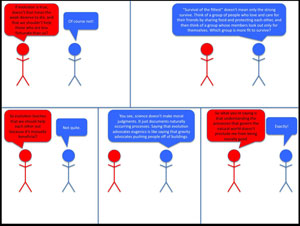
This cartoon attempts to allay a widespread and justified concern that evolution leads to a moral vacuum. Evolutionist Richard Dawkins did not dispute this, but simply said, “That’s just tough. We have to face up to the truth.”
By equating evolution with “science”, this cartoon tries to argue that evolution is merely about “naturally occurring processes” and has nothing to say about morals. However, this is deceitful. Julian Huxley, former Director-General of UNESCO, said,
“In the evolutionary pattern of thought there is no longer either need or room for the supernatural. The earth was not created: it evolved. So did all the animals and plants that inhabit it, including our human selves, mind and soul as well as brain and body. So did religion.”1
He said this in 1959 at the conference that celebrated the centennial of the publication of Origin of the Species and apparently none of the other evolutionists present disagreed—that is, evolution claims that everything evolved, including religion (and morals).
Will Provine, biology professor at Cornell, said:
“Let me summarize my views on what modern evolutionary biology tells us loud and clear … There are no gods, no purposeful forces of any kind, no life after death. When I die, I am absolutely certain that I am going to be completely dead. That’s just all—that’s gonna be the end of me. There is no ultimate foundation for ethics, no ultimate meaning in life, and no free will for humans, either.”2
The evolutionary view is that we are just atoms in motion. The whole universe popped into existence with no cause whatsoever and indeed we invented “god” (religion evolved). Evolution is far more than science; it is a pattern of thought; a worldview. Evolutionist philosopher of science Michael Ruse admitted it was a “secular religion—a full-fledged alternative to Christianity, with meaning and morality.”
And this anti-Christian worldview/religion has been smuggled into science classes. As one of Darwin’s mentors wrote soon after reading Origin,
“From first to last it is a dish of rank materialism cleverly cooked up … . And why is this done? For no other reason, I am sure, except to make us independent of a Creator.”
So it is quite deceitful to try to hoodwink people into thinking that evolution is just another branch of science.
Since evolution says “religion evolved”, “there are no gods” and it makes us “independent of a Creator”, morals are ultimately the result of chance collisions of atoms. Since this materialistic, God-free religion provides no sound basis for morality (as this cartoon tacitly admits), where does morality come from? (See What basis morality?) How can anyone say that any behaviour is right or wrong? What is the foundation for law within a society? If morality is merely a subjective personal choice, then ultimately “might” becomes “right”. Is it morally good to misrepresent your opponents, as these cartoons do? Is it morally good to kill babies in the womb, as well as those who have survived attempted abortion? What about euthanasia, pornography and same-sex marriage? The fact is that the evolutionary story justifies any behavior, but evolutionists do not like this being pointed out (see Darwin’s impact—the bloodstained legacy of evolution). Indeed, the so called culture war rages in the west at present over these and other hot issues because the moral standards of the Christian worldview conflict with those that come from secular evolutionary naturalism. (See Morality and Ethics Questions and Answers.)
Entry E (Brooke Lundquist from Niceville, FL):
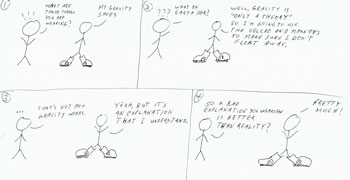
The “point”, such that it is, is basically the same as Entry A, so see our comments on that above. Also, that the judges should honour such a crass misrepresentation of creationist views reflects more on them than on us. Finally, their panel 4 is more applicable to evolutionists, by their own admission. For example, Lewontin would prefer a bad materialistic explanation rather than “allow a divine foot in the door” because of his “a priori … commitment to materialism”. Evolutionists’ minds are closed to even the possibility that God, or even some form of intelligent design, could be involved, no matter what the evidence! See Blinkered thinkers.
Entry F (Jan Stephan Lundquist from Niceville, FL):
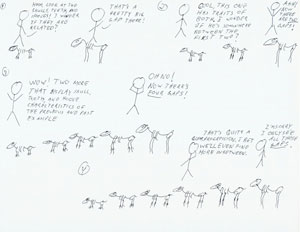
This cartoon shows stick drawings of a hypothetical series of animals, but how about a real life example? How about the sequence about Gogonasus—a fish with human limbs? When we look at real evidence we can see how it does not stack up. Animals are routinely arranged into cladograms that wrongly give the impression of evolutionary lineages. But they are not lineages. They merely show the relative similarities between certain traits of organisms. You can arrange a collection of teaspoons in a cladogram. And the gaps are real and ubiquitous, even 150 years after Darwin. See also Does a transitional form replace one gap with two gaps pointing out that two huge gaps is just as much a problem as one super-huge gap.
Entry G (Benjamin Tichy from Calistoga, CA):

This is a pathetic attempt to avoid the fact that irreducible complexity points to design (see An eye for creation). No one has a clue how the eye could have developed by unguided, unplanned, naturalistic processes (see Dawkin’s eye revisited). Simplistic line diagrams do not represent the complexity of the components of the eye—we are talking of precise sequences of many amino acids to form the proteins of a transparent lens, for example. And then there is the phenomenal biochemistry of light-sensitive cells and nerve fibres and vitreous humor and muscles and … . And it supposedly happened not just once but 40 different times with many different designs. The almond, too, is incredibly complex. It is not just a hunk of protein. Contained within the seed are all the genetic instructions for making an almond tree, along with the machinery needed to read the instructions, harvest the energy and raw materials from the environment and assemble the components into a new almond tree.
Entry H (Andrew Sarafan from Gainesville, FL):
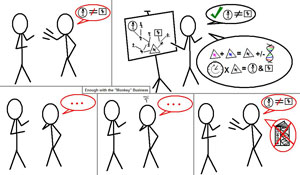
There are more personal attacks in this cartoon: creationists are aggressive (note the hand gesture), can’t understand science and are in denial. It is important to note that lines drawn on a board do not constitute evidence. They are just the way evolutionists interpret the evidence. It is actually the evolutionists who are in denial. They can’t explain the origin of life, the origin of multi-cellularity, the origin of new genetic information, the origin of sex, etc. And evolutionists themselves have questioned many previously “established” links between humans and apes—see for example Homo habilis hacked from the family tree.
Entry I (Stacy Scott from Saint Augustine, FL):
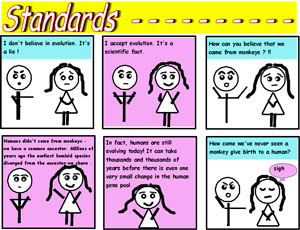
Another straw man and more mocking. See the discussion If we evolved from apes … in our Don’t use article. The alleged common primate ancestor of man and apes would certainly be called an ape or a monkey by most people who saw it (as was acknowledged by the famous evolutionist G.G. Simpson), and the evidence for such an ancestor is lacking (see Are there ape men in your ancestry? and Anthropology and ape men questions and answers).
Entry J (Christopher Thurtle from New Hampton, NY):

Yet another attack on the If-we-evolved-from-apes straw man. There must have been slim pickings if they had to reward identical straw man arguments.
Although these cartoons were created by young people who would not have an advanced knowledge or experience in the issues involved, they were nevertheless judged by prominent evolutionists who are engaged in the public debate over the creation-evolution controversy. It’s a sad reflection that such gross misconceptions were rewarded by the judges and put on public display. Clearly the Florida Citizens for Science and the National Centre for Science Education have a lot of work to do to dispel the misconceptions among their constituents if this debate is ever to focus on the scientific arguments. But evidently they find it easier to knock down straw men and resort to abusive ad hominem attacks than to actually deal with the real arguments that so seriously question the idea that everything made itself by natural processes without any intelligent Creator. Perhaps that’s because they have no adequate answers.
Recommended Resources
References
- in Essays of a Humanist [1964], Penguin Books, UK, 1969 reprint, pp.82–83. Return to text.
- Provine, W.B., Darwinism: Science or Naturalistic Philosophy? The Debate at Stanford University, William B. Provine (Cornell University) and Phillip E. Johnson (University of California, Berkeley), videorecording © 1994 Regents of the University of California. (See also: Origins Research 16(1):9, 1994; arn.org/docs/orpages/or161/161main.htm.) Return to text.


Readers’ comments
Comments are automatically closed 14 days after publication.